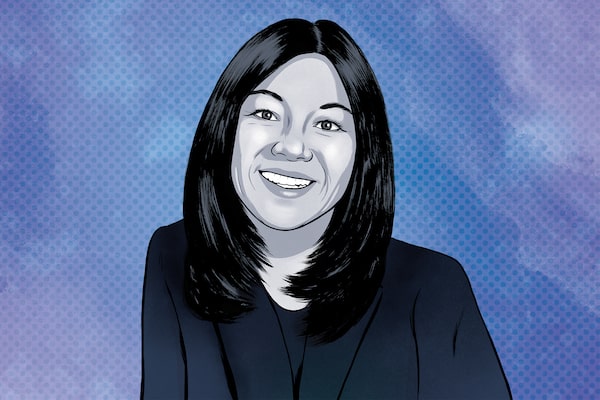
Illustration of Katherine Owen for The Mover. Oct. 15, 2022. Illustration by Joel KimmelThe Globe and Mail
One of the best investment decisions money manager Katherine Owen made over the past year was getting back into the energy sector.
The portfolio manager at Mackenzie Investments in Toronto says the team she works with sold out of energy in early 2020, just before prices started to drop amid the global pandemic lockdowns that dried up demand for oil and gas. The team started buying energy names again last year, believing the industry was well-positioned – following years of streamlining – to reap huge profits from the latest rebound.
It wasn’t just a call on consumers and companies using more oil and gas as they resumed prepandemic activities, but also a belief on the sector growing despite the rise in renewable energy.
“We think the death of the fossil-fuel industry has been overstated; we are going to need fossil fuels for a very long time, and we believe demand is going to continue to grow,” says Ms. Owen, who helps oversee about $11-billion in assets with the global equity and income team at Mackenzie Investments, including the $4-billion Mackenzie Global Dividend Fund, led by Darren McKiernan.
About 8 per cent of the fund today is energy, including big global players such as Chevron Corp. CVX-N, Marathon Petroleum Corp. MPC-N and Schlumberger Ltd. SLB-N
While there is a risk that energy demand will drop again if a more severe economic downturn comes, Ms. Owen believes it will be short-lived.
“We think energy companies are going to be in an attractive position and aren’t being fully valued by the market today,” she says.
The Mackenzie Global Dividend Fund also has positions in sectors such as technology (16 per cent), financials (18 per cent, which includes exchanges and data analytics companies), health care (15 per cent) and consumer staples (12 per cent). Some of those top holdings include Microsoft Corp. MSFT-Q, Deutsche Boerse DBOEY, Johnson & Johnson JNJ-N and Nestlé NSRGY.
The fund is down 8.6 per cent, in Canadian dollars, over the past year as of Sept. 30. That compares with a drop of 12.2 per cent for the benchmark MSCI World Index over the same period. Both results are based on total returns.
Ms. Owen says dividend-paying companies such as they own in the fund will become even more important in the months and years ahead, even amid market volatility.
“We believe that owning quality companies that can pay rising dividends is going to be a good place to be, not only for income but also to protect the purchasing power in times of inflation,” she says.
The Globe and Mail recently spoke to Ms. Owen about what she has been buying and selling.
Describe your investing style.
We are stock pickers. We identify high-quality companies with attractive and durable business models. We have what I call a fishing pond of about 400 of those companies that we use to build our portfolio. We also ensure the fund is properly diversified. We don’t want to be overly concentrated in one region or sector. We are very flexible in our approach and agnostic in our investment style. We don’t characterize it as value or growth. We look for the best businesses with the most attractive risk-return.
What’s your current market outlook?
I believe we may be in the midst of a market regime change. What has worked the best over the last 10 years – which was a very growth-driven market with low-interest rates and low inflation – will not necessarily be what will work over the next 10 years. Now we’re in a period where inflation and rates will likely be higher than they have been over the past decade. Also, the economy may not be on as solid a footing as it was over the previous 10 years because we don’t have that massive monetary stimulus from central banks that really supported a robust stock market and economic environment.
What have you been buying?
We’ve maintained or increased our positions in companies and industries that would benefit from higher rates and inflation, including energy, consumer staples and health care. We look to buy leaders in all of these industries. For instance, we bought Chevron, a major integrated company, Marathon, a refiner, and Schlumberger, an oil-services company. We also own Williams Cos. WMB-N, a pipeline company. In health care, we have increased our exposure to companies like AbbVie ABBV-N, probably best known as the maker of Botox, which we see as a very resilient business even amid an economic downturn. We have also been nibbling at some of the major technology names after reducing our exposure last year.
What have you been selling?
Late last year and earlier this year, we reduced our exposure to cyclical companies that benefited from low inflation and low interest rates. For example, one of our largest positions in the fund last year was private equity firm Blackstone Inc. BX-N, which we trimmed considerably. We didn’t sell out because, long-term, it’s a leading company in an industry we want exposure to. But we felt it would have some challenges in the short term. Equifax Inc., the credit-bureau company, was another major holding last year that we lightened up on, given the headwinds from the slowing housing market. Its mortgage business is a big driver of growth for this company.
What investing advice do you give friends and family when they ask?
I tell them how important it is to have a well-diversified portfolio. You don’t want to be overly concentrated in any one stock or sector. Given the regime shift in the market, I also think it’s important that people reassess their asset allocation and ensure they have the right risk exposure for their personal situation.
This interview has been edited and condensed.